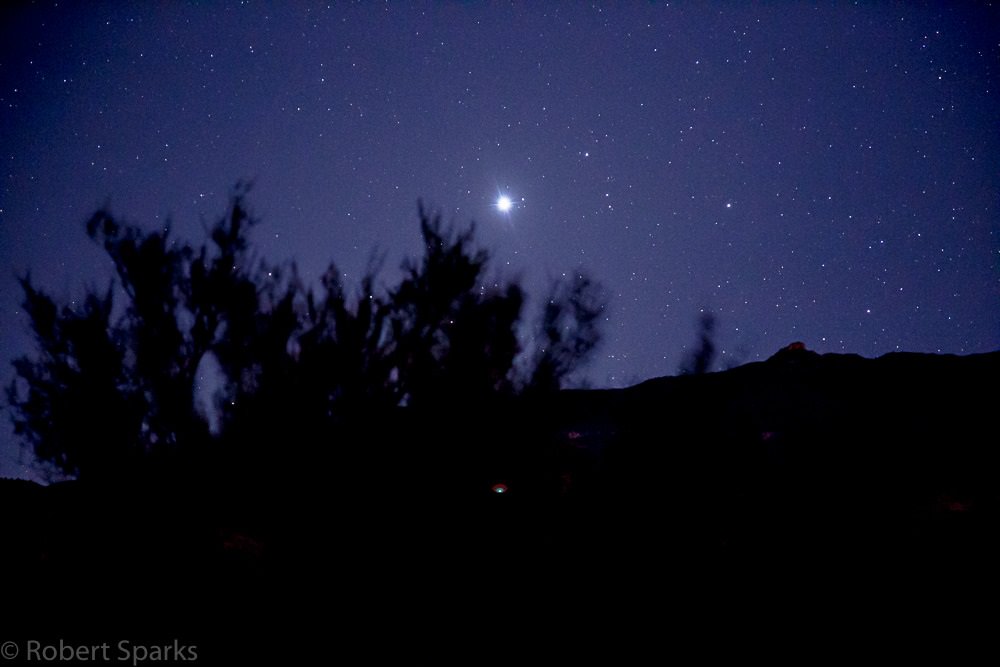Welcome to 2016! The early morning sky is where the action is this first week of the year. We were out early this Monday morning as skies cleared over Central Florida on our yearly vigil for the Quadrantid meteors. Though only a handful of meteors graced the dawn skies, we were treated to a splendid line-up, including Jupiter, Mars, Spica, Antares, Saturn, Venus, the waning crescent Moon AND a fine binocular view of Comet C/2013 US10 Catalina.
We’re always a bit skeptical of the Quadrantids. Its slim peak, coupled with a relative dearth of bright meteors makes it the elusive ‘unicorn’ of annual major meteor showers. Occurring in the dead of northern hemisphere winter certainly doesn’t help the ‘Quads in the PR department.
But there’s another reason to brave the cold this week, as two naked eye planets close in for one of the tightest conjunctions of 2016.
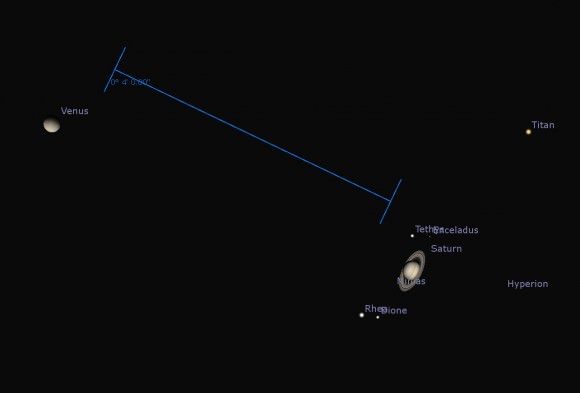
Venus and Saturn pass just 5′ (that’s 1/6th the diameter of the Full Moon!) apart on the morning of Saturday, January 9th. The conjunction (sometimes called an appulse) occurs at around 4:00 Universal Time (UT). This is the second closest conjuction of two naked eye planets for 2016: only the 4′ pairing of Jupiter and Venus on August 27th narrowly beats it out for top billing.
Update: Gadi Eidelheit caught some amazing images of the Moon-Venus-Saturn trio from Israel on the morning of Thursday, January 7th:
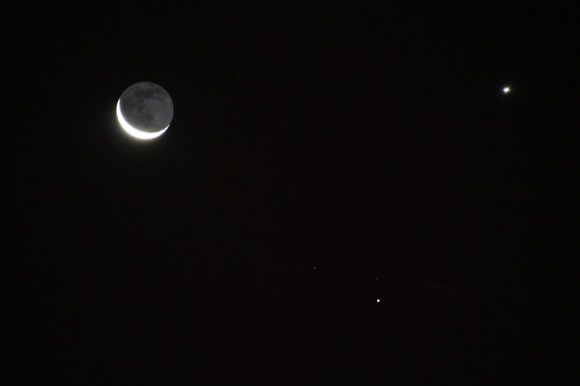
The January 9th conjunction occurs 36 degrees west of the Sun in the morning sky: expect the pair to be visible in the dawn low to the east, about two hours prior to sunrise. Venus shines at magnitude -4.0 with a 80% illuminated disk 14” across, while Saturn is nearly a hundred times fainter at magnitude +0.6 with a 15” diameter disk, 36” across if you count the span of its rings.
You’ll be able to spy both Saturn and Venus in the same telescopic field of view — ironically, on a Saturday morning — a rare catch. Can you split the two with the unaided eye? We once showed off a similar conjunction of Saturn and Venus to an astrology-minded friend on the morning of August 26th, 2006… we can only hope they came over to the ‘light side’ of astronomy.
To the unaided eye, Saturn will look like the ‘moon’ Venus never had Saturday morning. The pair closes the gap by nearly a degree a day this week. Curiously, the Earth-Moon system would look very nearly the same in terms of separation and brightness from the cloud tops of Venus.
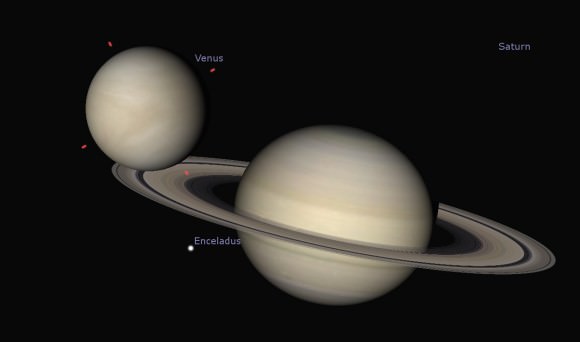
This is also the closest passage of the two planets for some time. We ran a simulation using Occult 4.2, and found this won’t be topped until July 22nd , 2037. Do the two ever meet? Stick around until August 12th, 2243 AD and you can actually watch Venus graze the rings of Saturn. Though no one alive today will live to see this event, we might just make it to November 22nd, 2065 to witness the transit of Venus across the face of Jupiter.
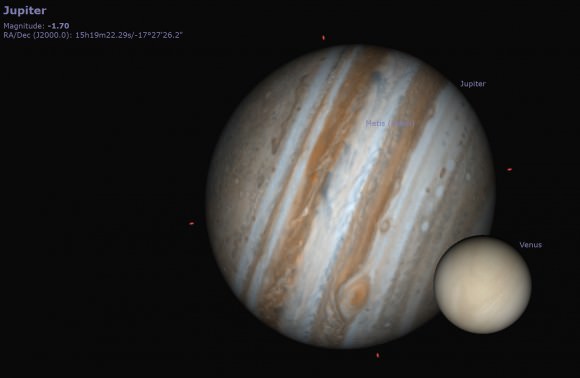
Venus is headed towards in superior conjunction on the far side of the Sun on June 6th, when it will actually pass behind the Sun as seen from the Earth for 46 hours. Venus will then slowly return to dusk skies for the remainder of 2016. Meanwhile, Saturn will grow more prominent in the dusk sky, as it heads towards opposition on June 3rd. Saturn’s rings are currently very prominent, and reach the maximum opening as seen from our Earthly vantage point on October 7th, 2017.
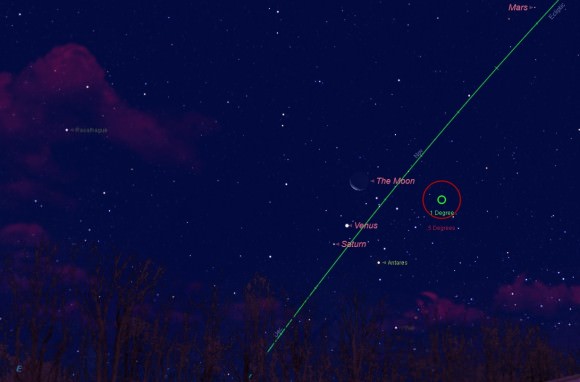
As a teaser leading up to the conjunction, the Moon joins the pair on the morning of Thursday, January 7th. We call such a multiple meet-up a lunar-planetary grouping, as opposed to a conjunction pairing. The Moon, Saturn and Venus will fit inside a circle less than four degrees wide—a fine view for binoculars—with the Moon just three days from New and the start of lunation 1151. Follow that Moon into the daytime, and you should be able to see Venus sitting off of its limb against the daytime sky several lunar diameters away on Wednesday and Thursday.
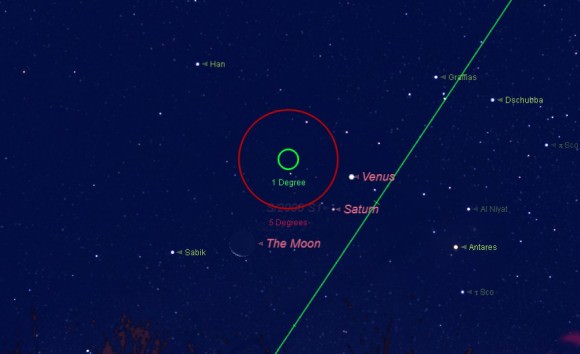
Let’s dive into the third dimension of what we’re seeing. The Moon is 1 1/4 light seconds away, representing the farthest humans have traveled in person. Venus is currently slightly more distant than the Sun, at 1.2 AU or 10 light minutes away. Comet US10 Catalina is 0.8 AU away in the constellation Boötes, and approaches closest to Earth at 0.7 AU distant on January 17th. Saturn lies 10.8 AU (1.5 light hours) away. The Huygens lander on the surface of Saturn’s moon Titan represents the most distant landing of a human-made object to date. Now, see the brilliant orange-red star Antares to the right of the pair? It’s 554 light years distant, and yet to receive our radio signals from our fledgling civilization by a factor of five.
Feeling puny yet? Hey, astronomy can do that to you. Don’t miss this weekend’s conjunction of Saturn and Venus as a fine way to kick off astronomy in 2016.

